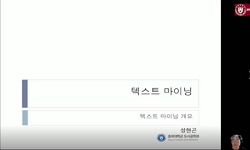This paper proposes a novel knowledge extraction system, TAKES (Two-step Approach for Knowledge Extraction System), which integrates advanced techniques from Information Retrieval (IR), Information Extraction (IE), and Natural Language Processing (NLP...
http://chineseinput.net/에서 pinyin(병음)방식으로 중국어를 변환할 수 있습니다.
변환된 중국어를 복사하여 사용하시면 됩니다.
- 中文 을 입력하시려면 zhongwen을 입력하시고 space를누르시면됩니다.
- 北京 을 입력하시려면 beijing을 입력하시고 space를 누르시면 됩니다.
https://www.riss.kr/link?id=A101570707
- 저자
- 발행기관
- 학술지명
- 권호사항
-
발행연도
2014
-
작성언어
English
- 주제어
-
등재정보
KCI등재,SCOPUS
-
자료형태
학술저널
-
수록면
6-21(16쪽)
- DOI식별코드
- 제공처
-
0
상세조회 -
0
다운로드
부가정보
다국어 초록 (Multilingual Abstract)
This paper proposes a novel knowledge extraction system, TAKES (Two-step Approach for Knowledge Extraction System), which integrates advanced techniques from Information Retrieval (IR), Information Extraction (IE), and Natural Language Processing (NLP). In particular, TAKES adopts a novel keyphrase extraction-based query expansion technique to collect promising documents. It also uses a Conditional Random Field-based machine learning technique to extract important biological entities and relations. TAKES is applied to biological knowledge extraction, particularly retrieving promising documents that contain Protein-Protein Interaction (PPI) and extracting PPI pairs. TAKES consists of two major components: DocSpotter, which is used to query and retrieve promising documents for extraction, and a Conditional Random Field (CRF)-based entity extraction component known as FCRF. The present paper investigated research problems addressing the issues with a knowledge extraction system and conducted a series of experiments to test our hypotheses. The findings from the experiments are as follows: First, the author verified, using three different test collections to measure the performance of our query expansion technique, that DocSpotter is robust and highly accurate when compared to Okapi BM25 and SLIPPER. Second, the author verified that our relation extraction algorithm, FCRF, is highly accurate in terms of F-Measure compared to four other competitive extraction algorithms: Support Vector Machine, Maximum Entropy, Single POS HMM, and Rapier.
동일학술지(권/호) 다른 논문
-
- Korea Institute of Science and Technology Information
- Puttaswamy, R.M.
- 2014
- KCI등재,SCOPUS
-
Sino-South Korean Scientific Collaboration Based On Co-Authored SCI Papers
- Korea Institute of Science and Technology Information
- Sun, Junwei
- 2014
- KCI등재,SCOPUS
-
Korea's STEM Research Analysis Based on Publications in the Web of Science, 1968-2012
- Korea Institute of Science and Technology Information
- Kim, Byungkyu
- 2014
- KCI등재,SCOPUS
-
Publication Trends and Citation Impact of Tribology Research in India: A Scientometric Study
- Korea Institute of Science and Technology Information
- Rajendran, P.
- 2014
- KCI등재,SCOPUS






 ScienceON
ScienceON


